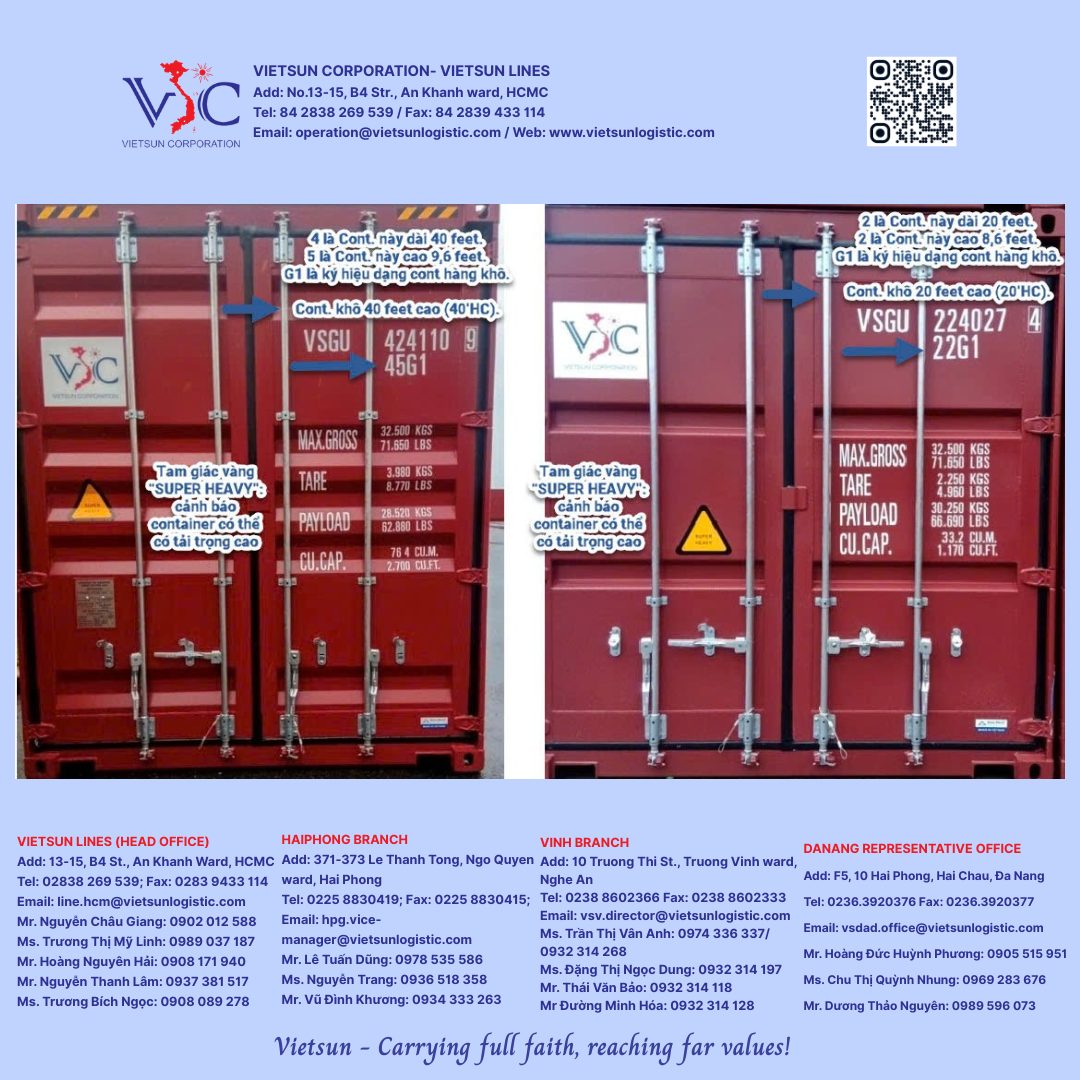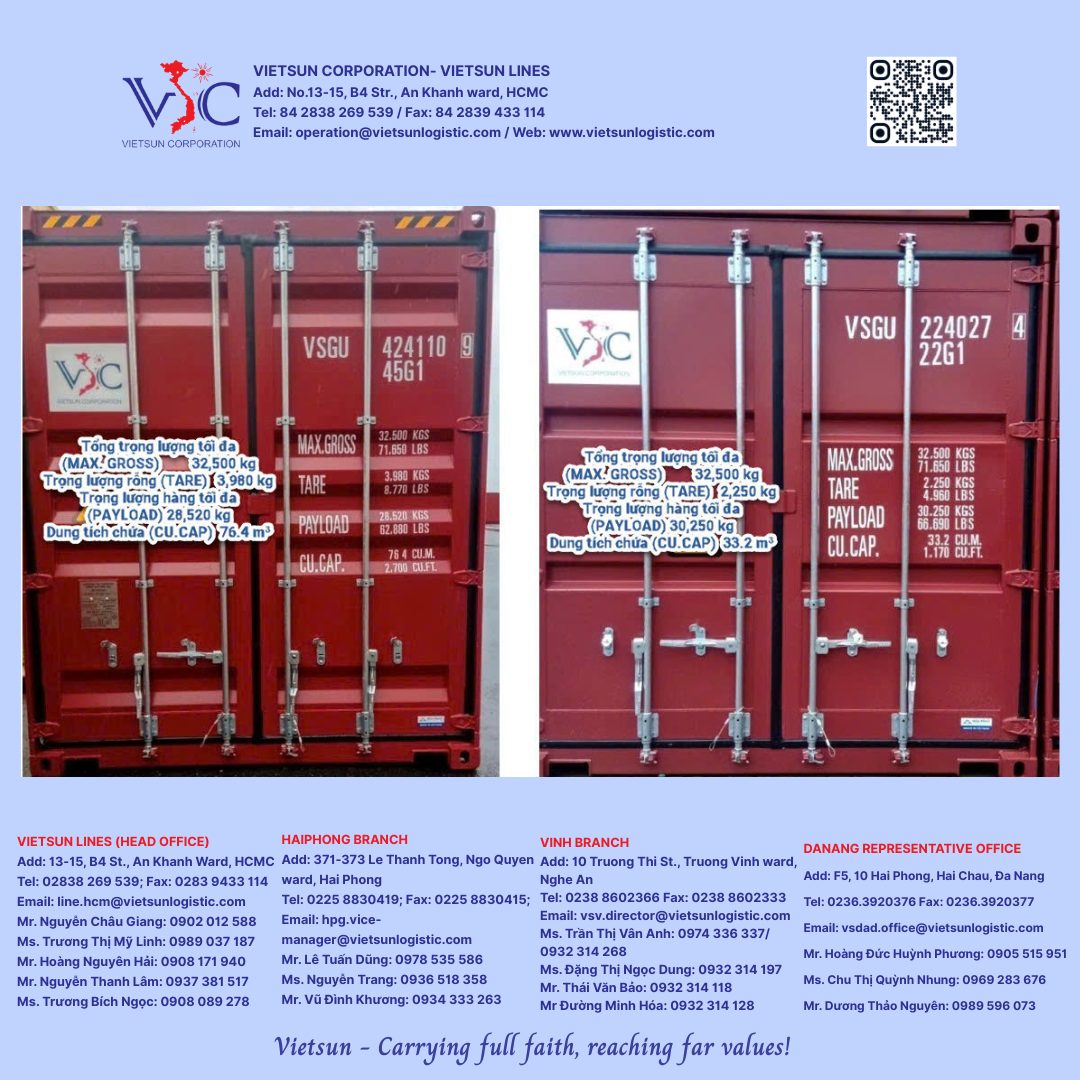Have you ever wondered what the container symbols mean? How are they classified and how to read container parameters correctly? Join Vietsun Logistics to “discover” the meaning of the symbols on the container through numbers.
What is a container? Why are there symbols on containers?
Container (Cont) is a specialized tool used to transport large quantities of goods. Containers are used with many different means of transport in the transport industry such as road, sea, rail and air. After many years of development, the types of containers have been unified. Cont code parameters according to ISO 6346:1995 standard.
How to read the symbol code on the container
1. Container number
Each container has a unique identification code consisting of 4 characters, divided into two parts: the first 3 characters and the last character. In which:
– First 3 characters: The container owner's code, registered with an international registry or the International Container Bureau (BIC).
– Last character: Used to classify container shells. The three characters that appear will be U, J or Z.
U: Freight container
J: Detachable freight container-related equipment
Z: Trailer or chassis
For example, VSGU stands for:
VSGU: The first 3 letters are the owner code of Vietsun Corporation, U represents the type of freight transport.
➡️ So VSGU is understood as a cargo container of Vietsun Corporation.
2. Container serial number
The next 6 digits after the owner code are the container serial number in the owner's management system, ensuring non-duplication (only used once). If the number is less than 6 digits, a 0 will be added in front. For example, the number 424110 in the illustration is the container serial number.
3. Check digit
The check digit (number 9 in the illustration) is the last digit, printed and framed on the container, used to check the accuracy of the container number, avoiding duplication. This code helps to identify the container uniquely worldwide (used in ship tracking, manifest, booking...)
Container size and type identification code
The container size and type identification code consists of 4 characters, of which:
– The first 2 characters represent the size code.
– The last 2 characters represent the container type code.
1. Size code (first 2 characters)
The size code consists of numbers or letters, specified as follows:
The first character represents the container length:
– 2: 20 feet (20') long container.
– 4: 40 feet (40') long container.
– L: 45 feet (45') long container.
The second character represents the container height:
– 0: Height 8 feet (8').
– 2: Height 8.6 feet (8'6").
– 5: Height 9.6 feet (9'6").
 2. Container type code (last 2 characters)
2. Container type code (last 2 characters)
This code consists of one letter and one number:
The first character indicates the container type:
– G: General container.
– R: Refrigerated container (Refrigerated container).
– U: Open top container.
– T: Tank container (Tank container).
– P: Platform container.
The last character represents the structure of the container:
– 0: Can open 1 or 2 ends of the door.
– 1:There is a vent on top.
– P: Combine both types above (open and ventilated).
For example, 45G1 is understood as follows:
45 → container 40 feet (12,192 mm) long, 9'6” (2,896 mm) high – called High Cube.
G1 → dry cargo container (General Purpose).
➡️ So this is a 40 feet high dry container (40'HC).
Container Operator Code
In addition to the above identification codes, each container has other detailed parameters showing its cargo capacity. Among them:
– MAX.GROSS (Max Gross Weight): Maximum total weight allowed, including container shell and cargo inside.
– TARE: Weight of container shell.
– NET: Maximum weight of goods that the container can hold.
– CU.CAP. (Cubic Capacity): Cargo capacity, measured in cubic meters (m³) or cubic feet (ft³).
Load parameters
| Parameter | Meaning | Value (KGS) | Value (LBS) | Note |
|---|---|---|---|---|
| MAX. GROSS | Maximum total weight of container (including cargo and container shell) | 32,500 | 71,650 | Do not exceed this limit when transporting. |
| TARE | Container weight (empty) | 3,980 | 8,770 | Used to calculate the actual weight of goods |
| PAYLOAD | Maximum weight of goods that can be carried | 28,520 | 62,880 | = MAX.GROSS – TARE |
| CU. CAP. | Cargo capacity (volume inside the container) | 76.4 m³ | 2,700 cu.ft | Suitable for dry, non-liquid goods |
💡 Load test formula:
MAX.GROSS = TARE + PAYLOAD
➡️ 32,500 = 3,980 + 28,520
Sub-symbols
VSC Logo (Vietsun Corporation): Container owner.
Yellow triangle symbol “SUPER HEAVY”: Warning that the container may have a high load.
Inspection label and specification plate (CSC Plate): usually in the lower corner, records technical information and container safety certification according to the CSC Convention (Convention for Safe Containers).
Above is a summary of information. Container symbol and the meaning of the symbols.
Vietsun Logistics provides all domestic container transportation solutions, meeting the diverse and flexible needs of customers. Follow Vietsun's website and associated platforms to get more useful information about domestic transportation and choose the most optimal logistics solution.
📞 Hotline: 028 3826 9539 or contact Vietsun customer care staff
📧 Email: admin@vietsunlogistic.com
🌍 Website: www.vietsunlogistic.com
Vietsun – Transport full trust, reach out values


 2. Container type code (last 2 characters)
2. Container type code (last 2 characters)